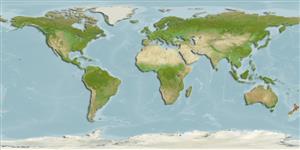Teleostei (teleosts) >
Blenniiformes (Blennies) >
Tripterygiidae (Triplefin blennies) > Tripterygiinae
Etymology: Blennodon: Greek,blenios = mucus + Greek, odous = teeth (Ref. 45335).
Environment: milieu / climate zone / depth range / distribution range
Ecology
Marine; demersal; non-migratory; depth range 0 - 8 m (Ref. 13227). Temperate
Southwest Pacific: endemic to New Zealand.
Size / Weight / Age
Maturity: Lm ? range ? - ? cm
Max length : 15.1 cm SL male/unsexed; (Ref. 13227)
Short description
Identification keys | Morphology | Morphometrics
Dorsal spines (total): 21 - 24; Dorsal soft rays (total): 12 - 13; Anal spines: 0; Anal soft rays: 24 - 26. Pale to dark greyish-green in color, breaking up into four broad saddles on the body with pale green and white between. Belly white. Fins dark mottled olive-green. Distinguished from other triplefins by its large size and rounded bulbous head, the lateral line which is continuous to the caudal peduncle and rows of large recurved teeth in the jaws.
Adults prefer exposed reefs and deeper pools. Also found in rock pools (Ref. 9003). Eggs are hemispherical and covered with numerous sticky threads that anchor them in the algae on the nesting sites (Ref. 240). Larvae are planktonic which occur primarily in shallow, nearshore waters (Ref. 94114). B. dorsalis is the largest known triplefin species and the only fish predator in the family (Ref. 13227).
Life cycle and mating behavior
Maturities | Reproduction | Spawnings | Egg(s) | Fecundities | Larvae
Fricke, R., 1994. Tripterygiid fishes of Australia, New Zealand and the southwest Pacific Ocean (Teleostei). Theses Zool. 24:1-585. (Ref. 13227)
IUCN Red List Status (Ref. 130435)
Threat to humans
Harmless
Human uses
Fisheries: of no interest
Tools
Special reports
Download XML
Internet sources
Estimates based on models
Phylogenetic diversity index (Ref.
82804): PD
50 = 1.0000 [Uniqueness, from 0.5 = low to 2.0 = high].
Bayesian length-weight: a=0.01000 (0.00244 - 0.04107), b=3.04 (2.81 - 3.27), in cm total length, based on all LWR estimates for this body shape (Ref.
93245).
Trophic level (Ref.
69278): 3.4 ±0.4 se; based on size and trophs of closest relatives
Resilience (Ref.
120179): High, minimum population doubling time less than 15 months (Preliminary K or Fecundity.).
Fishing Vulnerability (Ref.
59153): Low vulnerability (10 of 100).
